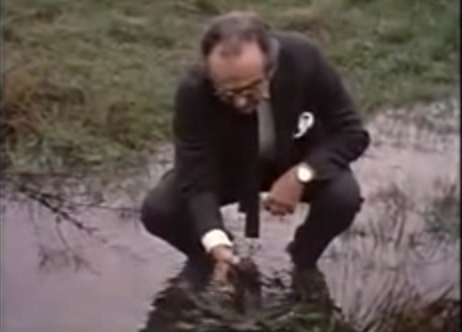"When myth incarnates in the waking world...”
Relationship Theory: The Ten Laws
For a more in-depth look at Relationship Theory, read pp. 47-68 of Mythorealism: When Myth Incarnates in the Waking World by C.S. Thompson. This
Relationship Theory: Metaphysical Principles of Mythorealism

Jacob Bronowski at the pond in Auschwitz
Dave Thompson, the creator of Relationship Theory, liked to compose music ranging from somber and dramatic neoclassical compositions to surreal avant garde symphonies and contemporary trance pieces with driving dance beats. While much of his music was light-hearted or even whimsical, some of his most interesting work was heavy to the point of morbidity, including a classical piece called Jacob at the Pond. This piece of music was inspired by a scene in the BBC documentary series The Ascent of Man where Jacob Bronowski visits the pond at Auschwitz and speaks the following words:
"Look for yourself. This is the concentration camp and crematorium at Auschwitz, this is where people were turned into numbers. Into this pond were flushed the ashes of four million people. And that was not done by gas. It was done by arrogance. It was done by dogma. It was done by ignorance. When people believe that they have absolute knowledge, with no test in reality, this is how they behave. This is what men do when they aspire to the knowledge of gods."
Relationship theory was all about the death of absolute knowledge, the necessity of playing with multiple perspectives at the same time in order to approximate a larger truth. Dave would always say that humanity must somehow overthrow the gods, achieving a new freedom and an apotheosis.
Although he never wrote relationship theory up into a formal system, he talked about it extensively over a period of many years with various members of his family and did a lot of work with his oldest son, Jason Thompson, to try to formalize and expand the concept.
In the end, though, the only written explanation he ever left of his theory was a set of somewhat whimsical aphorisms he called the "ten laws" and several pages of obscure notes.
The Ten Laws
- Interactions are the reality, form is the illusion
- The simpler the concept, the more complex its ramifications.
- The seeds of the solution are buried in the question.
- Always ring the changes.
- Never ignore serendipity.
- Ignore all laws at least once a week on general principles.
- Negative feedback is a positive idea.
- Dynamic tension is required for control.
- All forces are infinite.
- The strongest chains have the most subtle links.
He believed that these ideas could be used to work your way through virtually any problem in life, from a broken car to a thorny philosophical question.
Reality, in his view, was not an absolute thing but a constantly shifting network of relationships and perspectives in an infinitely complex pattern of interactions. The key to understanding this chaos was not to seek a better perspective on it- as he always used to say, "there is no superior rock on which to stand"- but to learn how to shift fluidly and effortlessly from one perspective to another, "ringing the changes" to get a gestaltic impression of the entire universe.
The ten laws were his guidelines on how to do so.